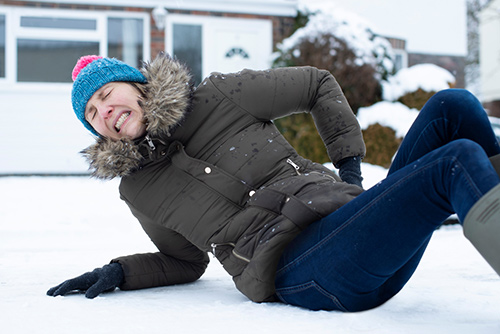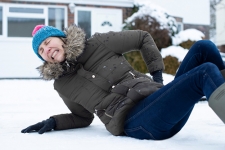
*When it’s cold out, be of the mindset that ANY wet/dark area of pavement could be slippery and icy. Even if there hasn’t been any actual precipitation, dew and water vapor can freeze on cold surfaces which, in turn, can form an extremely thin and nearly invisible layer of ice that can look like wet pavement but is anything but.
- Don’t take shortcuts (across lawns or over mounds of snow). And, walk in areas that are designated for pedestrians as much as possible. If you encounter an icy patch of sidewalk, walking along the grassy edge may help provide you with a bit of traction.
- When you’re walking, walk as flat-footed as possible and bend slightly, so that your center of gravity is directly over your feet. Also, keep your hands out of your pockets! Instead, extend your arms out to your sides to help maintain balance. Heavy loads – like backpacks – can throw off your sense of balance, so be especially cautious if you’re weighted down with a bag.
- Always make sure you watch where you’re going and always go slow! The faster you’re moving the less reaction time you’ll have in regards to changing traction and keeping your balance. Taking short steps and shuffling can also help with stability.
- If you’re going down stairs, use the hand railing (it’s there for a reason) and place your feet firmly on each stair, and pause for just a moment before going to the next stair.
- Be extra vigilant when getting into – and out of – vehicles. Parking lots are notorious for having patches of ice scattered throughout.
- Choose appropriate footwear! High heels are a total “no no!”, and boots and shoes with smooth soles should be avoided as well. Opt for footwear that can provide some traction on snow and ice – grooved soles are the best.
Whatever you do, be careful out there! Remember, slow and steady (coupled with a sturdy pair of shoes) always wins the race.

